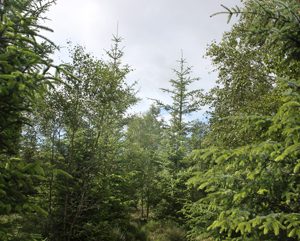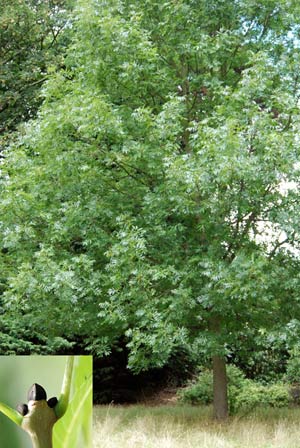More productive forestry trees (and Dr Steve Lee).

Since 1960 commercial trees in the UK have become about 25% more productive. This has been achieved through selective breeding, mostly of Sitka Spruce and Scots pine where plants have been chosen for their rapid growth. It has also led to better quality timber which produces more sawlogs. Unfortunately according to the Forestry Commission's Steve Lee, no similar effort has been made with broadleaved trees so they have suffered a relative disadvantage compared to the progress with conifers. He says, "We dropped tree selection for broadleaved trees in the 1960s because it was thought to be not worthwhile."
The main problem with traditional tree breeding is that you have to wait so long before you can make each selection, having to wait for trees to reach maturity before you can select the best ones. However, new methods have allowed the process to be hugely accelerated - the  DNA of trees can be screened to make links with particular characteristics so the more promising seeds can be used. Also, once these are planted the new timber can be tested after just a few years rather than after several decades. Steve Lee says there are two methods of timber testing which really help: testing the wood's "acoustic velocity" for strength, and testing the density of the wood by controlled shooting of nails into it. Together these techniques are rapidly accelerating the development of tree strains that are both more productive and more useful.
DNA of trees can be screened to make links with particular characteristics so the more promising seeds can be used. Also, once these are planted the new timber can be tested after just a few years rather than after several decades. Steve Lee says there are two methods of timber testing which really help: testing the wood's "acoustic velocity" for strength, and testing the density of the wood by controlled shooting of nails into it. Together these techniques are rapidly accelerating the development of tree strains that are both more productive and more useful.
As well as breeding for more productive trees Steve Lee's team is breeding trees to be more resistant to disease. Recently the number of studies on ash trees have been increased to find trees that are resistant to chalara ("ash dieback"). This is possible because ash trees have a high degree of variability and their characteristics can be passed on to offspring (another words they are heritable). In contrast, Elm has so far proved very difficult to breed in a way that is resistant to Dutch Elm disease.
Key to this research is being systematic and keeping good records. Steve Lee makes sure that the Forestry Commission's Forest Research keeps an archive of work they have done and of the seeds they have selected. The Tree Improvement section of the Forestry Commission's website gives lots more information: click here.
Comments are closed for this post.
